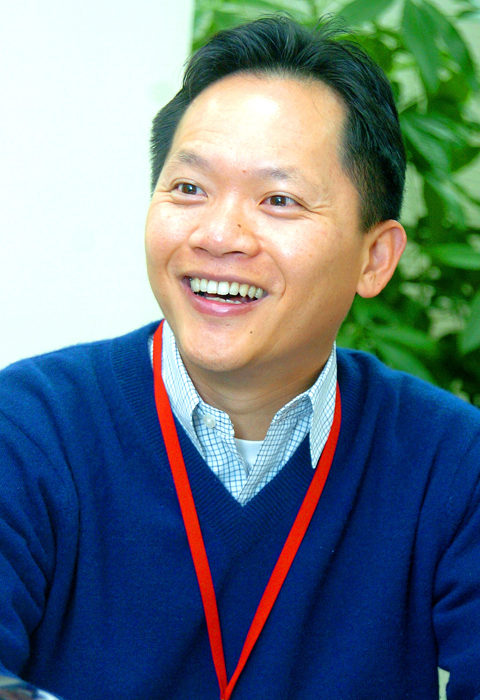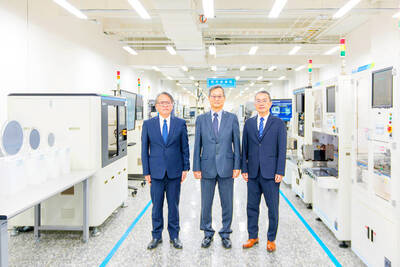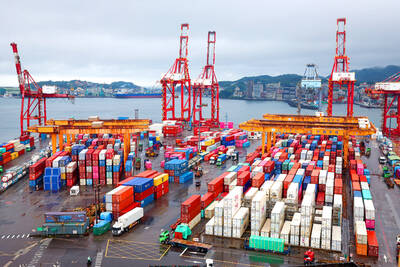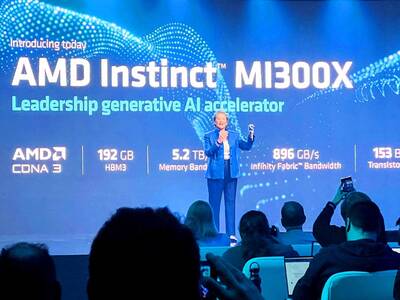You may not know the software company DeviceVM Inc (達維飛碼), based in San Jose, California, but you could be familiar with its product, which is used by several computer vendors.
Asustek Computer Inc (華碩) labels DeviceVM’s “instant-on” technology as “Express Gate” on its laptops, which allows the computers to boot-up in a few seconds.
Lenovo Group Ltd (聯想) calls its notebooks’ quick-boot function “Quick Start,” while Hewlett-Packard Co says its printers can produce faster printouts with zero warm-up time, thanks to this time-saving operating system platform.

PHOTO: CHANG CHIA-MING
Founded in 2006 by a team of Massachusetts Institute of Technology graduates, with offices in Taipei, Shanghai, Hangzhou and San Jose, DeviceVM has strong roots in Taiwan.
The software startup received its initial funding from major Taiwanese technology industry heavyweights such as Asustek, Acer Inc (宏碁), Hon Hai Precision Industry Co (鴻海精密) and HTC Corp (宏達電) and essentially rode on the netbook boom. Its “instant-on” technology is sold pre-installed on personal computers made by global vendors.
Prior to the Consumer Electronics Show (CES) in Las Vegas last month, DeviceVM stayed largely out of the public eye while reaping a steady stream of revenue every time a computer is purchased.
“We focused on marketing synergy,” Mark Lee (李明勳), DeviceVM’s chief executive officer, said of the start-up’s strategy to cobrand with various PC makers rather than to promote the “instant-on” technology under its Splashtop brand.
“We didn’t insist on showcasing our brand because we understand the need for PC vendors to strengthen theirs and create customized solutions for their discerning clients. But if you look closely, you’ll see the words ‘powered by Splashtop’ when our pre-OS platform opens up. We have insisted on this branding guideline with every manufacturer we work with,” Lee said in an interview with the Taipei Times on Jan. 16.
“Cooptition” is how Lee terms DeviceVM’s relationship with PC vendors — a combination of “collaboration” and “competition.”
He sees computer makers as business partners, yet recognizes the fact that these partners can turn into competitors at anytime and introduce their own versions of quick-boot capabilities.
Lee said there was no way of knowing where rivals will pop up until a product actually rolls out. He said he was somewhat relieved by the cost-cutting underway at every major tech company around the world because the chances that companies would spend R&D money to develop proprietary “instant-on” technology appears unlikely right now.
Instead of waiting for competitors to surface, however, DeviceVM is mapping out a global presence. By opening up its Splashtop platform to developers worldwide, it hopes to gain a wide array of different usage models and attract even more end users.
Lee said DeviceVM hoped to develop a strong and irreplaceable ecosystem of Splashtop users and strengthen its platform dominance the way Microsoft did with Windows OS.
Lee envisions Splashtop being deployed in other hardware devices through “convergence” — the inter-linkage between computing and IT, media content and communication networks that has risen because of the Internet’s explosion in popularity.
“At CES, Intel and Yahoo announced a partnership to bring Web content to televisions; this is a perfect example of convergence. Intel is leveraging on its success in building central processing units [CPUs] for PCs into the TV industry, just like it did recently with the introduction of Atom processors to reach into ultra mobile devices,” Lee said.
In essence, wherever Intel goes, it paves the way for DeviceVM. From Splashtop’s “instant-on” technology in netbooks running on Atom processors, DeviceVM can easily expand Splashtop into the handheld device market as well. The possibilities for Splashtop to migrate into other hardware devices are endless, Lee said.
The third leg of Lee’s long-term vision is perfecting DeviceVM’s technology to stay ahead of the game.
The company plans to transform Splashtop into a “virtual” platform that allows users to perform simple tasks on the pre-OS platform, while simultaneously booting up Windows in the background, he said.
“One core can run Splashtop, while the rest can be used to power up Windows. It’s a very effective use of computing power,” Lee said.
Additional features will be created to enable users to switch to and from Splashtop platform to programs such as Word, Excel or PowerPoint, he said.
Lee said the IT industry was heading toward a shift to cloud computing in the near future as value and content move onto the Internet.
“New business models and services will be recreating the whole industry, making software expertise ever more valuable,” he said.
This is something that Taiwan will not want to miss, he said.
Lee and his team hope to see Taiwan as a world-class IT center. To Lee, software and hardware expertise are critical in building this complete IT center. While Taiwan has a solid foundation in hardware, its weakness lies in software development, he said.
Lee and DeviceVM are working to foster local software talents. The company tries to recruit some of the brightest minds in the country while introducing them to cutting-edge software ideas from the US. Device VM now has 200 employees, with 180 engineers based in Asia, Lee said. In time, these young engineers will become local software leaders and strengthen Taiwan’s software expertise, he said.

ELECTRONICS BOOST: A predicted surge in exports would likely be driven by ICT products, exports of which have soared 84.7 percent from a year earlier, DBS said DBS Bank Ltd (星展銀行) yesterday raised its GDP growth forecast for Taiwan this year to 4 percent from 3 percent, citing robust demand for artificial intelligence (AI)-related exports and accelerated shipment activity, which are expected to offset potential headwinds from US tariffs. “Our GDP growth forecast for 2025 is revised up to 4 percent from 3 percent to reflect front-loaded exports and strong AI demand,” Singapore-based DBS senior economist Ma Tieying (馬鐵英) said in an online briefing. Taiwan’s second-quarter performance beat expectations, with GDP growth likely surpassing 5 percent, driven by a 34.1 percent year-on-year increase in exports, Ma said, citing government

SMART MANUFACTURING: The company aims to have its production close to the market end, but attracting investment is still a challenge, the firm’s president said Delta Electronics Inc (台達電) yesterday said its long-term global production plan would stay unchanged amid geopolitical and tariff policy uncertainties, citing its diversified global deployment. With operations in Taiwan, Thailand, China, India, Europe and the US, Delta follows a “produce at the market end” strategy and bases its production on customer demand, with major site plans unchanged, Delta president Simon Chang (張訓海) said on the sidelines of a company event yesterday. Thailand would remain Delta’s second headquarters, as stated in its first-quarter earnings conference, with its plant there adopting a full smart manufacturing system, Chang said. Thailand is the firm’s second-largest overseas

‘REMARKABLE SHOWING’: The economy likely grew 5 percent in the first half of the year, although it would likely taper off significantly, TIER economist Gordon Sun said The Taiwan Institute of Economic Research (TIER) yesterday raised Taiwan’s GDP growth forecast for this year to 3.02 percent, citing robust export-driven expansion in the first half that is likely to give way to a notable slowdown later in the year as the front-loading of global shipments fades. The revised projection marks an upward adjustment of 0.11 percentage points from April’s estimate, driven by a surge in exports and corporate inventory buildup ahead of possible US tariff hikes, TIER economist Gordon Sun (孫明德) told a news conference in Taipei. Taiwan’s economy likely grew more than 5 percent in the first six months

SUPPLY RESILIENCE: The extra expense would be worth it, as the US firm is diversifying chip sourcing to avert disruptions similar to the one during the pandemic, the CEO said Advanced Micro Devices Inc (AMD) chief executive officer Lisa Su (蘇姿丰) on Wednesday said that the chips her company gets from supplier Taiwan Semiconductor Manufacturing Co (TSMC, 台積電) would cost more when they are produced in TSMC’s Arizona facilities. Compared with similar parts from factories in Taiwan, the US chips would be “more than 5 percent, but less than 20 percent” in terms of higher costs, she said at an artificial intelligence (AI) event in Washington. AMD expects its first chips from TSMC’s Arizona facilities by the end of the year, Su said. The extra expense is worth it, because the company is